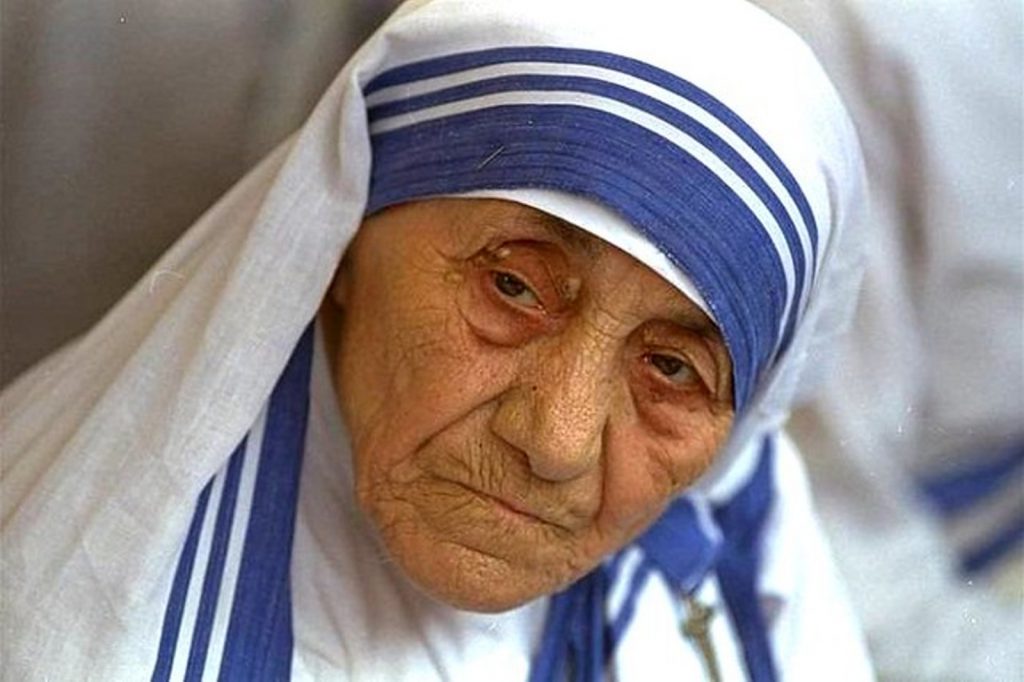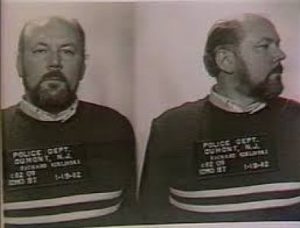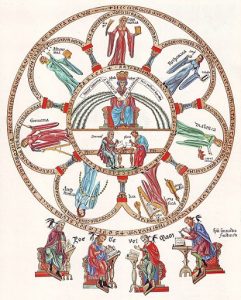On September 10, 1946, Mother Teresa felt her second vocational calling. She had been doing missionary work with the Loreto Sisters for eighteen years. But on this day, she felt what she called “a call within a call.” It was the moment when she received a request from God to do more for people in need. She wanted to start her own congregation for the people living in the slums, who often had a spirit of poverty and happiness. Although Mother Teresa wanted to start her own congregation and leave the Loreto school in Darjeeling, India to go to Calcutta, she wanted to keep her vows. Father Van Exem would call this day “Inspiration Day,” or more accurately, “Inspirations Days.”1 Father Van Exem was the person Mother Teresa trusted to help her satisfy her vision, and he later became the most important person when communicating information about Mother Teresa’s request to Archbishop Perier. So what led Mother Teresa to this point of decision in her life?
Mother Teresa, born Agnes Gonxha Bojaxhiu, was a devoted woman who spent her life helping others. At the age of twelve, she received her first “call” from God and found herself drawn to the religious life.2 At the age of eighteen, she decided to join the convent, and it was then that she became Sister Teresa. Mother Teresa was raised in a Catholic family and both of her parents were people of faith, which brought her closer to her faith and to her desire to help others. Skopje, the birthplace of Mother Teresa, was not a place where young women often entered the convent. When she made the decision to do so, it was a surprise to all of her family, especially because she would move to a distant place where she could focus on her service.3 Moving to Darjeeling was the beginning of Mother Teresa’s legacy.
Mother Teresa’s second call, to go to Calcutta, was a message that she felt was unambiguous. She stated, “I was to leave the convent and help the poor while living among them. It was an order. To fail would have been to break the faith.”4 After September 10, 1946, Mother Teresa experienced a retreat, during which she grew deeply engrossed in her prayers. While she was away for this time of silence, prayer, and reflection, she often wrote her thoughts on paper, which was later received by Father Van Exem. Mother Teresa’s vision was not going to be easy to accomplish. She wanted to leave the Loreto Order while keeping her vows, which was a decision that had to be approved of by the Archbishop. As weeks went by, Mother Teresa continued to pray and her vision remained the same. She wanted to live in the slums and help the less fortunate. The only person who knew about Mother Teresa’s call at the time was Father Van Exem, and his response was that she should continue to pray until January 1947. He then directed her to write a letter to the archbishop, and Father Van Exem offered to talk to him directly to get a response to the request.5

The archbishop’s first response was not favorable. He did not understand how a priest could encourage a nun to leave the convent, but he did not claim to know what God’s will was. Besides, Calcutta already had a charity order dedicated to the poor. If the archbishop was to approve her decision, it would seem like an irresponsible decision to let a nun live by herself in the slums of India.6 There were several risks involved in Mother Teresa’s request. During that time, India was suffering from religious violence. Indians believed that all European people, including priests and nuns, were bad influences on the people.7 Although Mother Teresa’s intentions were pure, the archbishop still denied her permission, and he did not authorize sending her application to Rome for a year.
Mother Teresa’s response to this was expected. She did not accept the decision and sent Father Van Exem to talk to the archbishop again, but the archbishop gave the same response. Deciding to accept his decision, Mother Teresa focused on prayer and did not tell anybody about her plans. Only Father Van Exem knew, not her Loreto superiors, nor the Calcutta priests who were close friends with Mother Teresa.8 As time went by, they both knew that it was not going to be long before someone noticed Mother Teresa’s plan to leave Darjeeling. Due to Mother Teresa’s talks with the spiritual director, her superiors became suspicious, but they did not catch on. Soon, it became known that Mother Teresa was transferring to Asansol, which was about three hours away from Calcutta. Father Van Exem believed he was not going to be involved in Mother Teresa’s mission after her transfer, but he received a big surprise when the archbishop sent him a letter ordering him to continue being her spiritual guide. While Mother Teresa was in Asansol, she continued teaching children geography and preparing them for their first communion. Mother Teresa was happy and she continued writing letters to Father Van Exem, but it still wasn’t her end goal.
After six months, Mother Teresa was taken to Calcutta at the request of Archbishop Perier. His explanation for this change was that he had “serious reasons.” When this decision was made, the archbishop fell ill and continued to insist that Mother Teresa wait a whole year before making a permanent decision. Due to his illness, Mother Teresa prayed for him to get better. If it did happen, she would use that as her motivation to complete her missionary work. Archbishop Perier recovered from his illness and Father Van Exem claimed that it was a sign for Mother Teresa to start her work in Calcutta.9 The archbishop’s illness can be considered an important moment in Mother Teresa’s journey. At first, he was persistent in his belief that allowing Mother Teresa to start her own congregation would be an act of rebellion. After he recovered, he had a change of heart about Mother Teresa’s request.
Without revealing Mother Teresa’s name, the archbishop consulted Father Henry, a priest in the Loreto Order, about the possibility of a Mother working in the slums of Calcutta. Father Henry believed it was a good idea. After this consultation, the archbishop also went to the General of the Society of Jesus (Jesuits) and to a specialist on Canon Law in Rome. In January 1948, Mother Teresa wrote a letter to the archbishop, once again requesting permission to leave the Loreto Order. In the letter’s response, she received permission and was advised to talk to her superiors in the Loreto Order instead of writing directly to Rome. Father Van Exem then suggested that she request an indult of exclaustration, which would allow her to leave the convent and keep her religious vows, but she would still have to answer to the archbishop.10
The archbishop had a different idea. He wanted her to request an indult of secularization, which would mean that when she left the convent of Loreto, she could never return. After Father Van Exem explained the differences between the two options of indult, Mother Teresa’s first choice was the indult of exclaustration. This was the obvious choice, because it allowed her to do what she had wanted since the beginning: keep her vows, but do her work in Calcutta. When the archbishop read her letter, he crossed out the word “exclaustration” and told Mother Teresa to trust the Mother general. Mother Teresa, trusting what the archbishop had told her, then requested an indult of secularization instead.11 With the help of the archbishop, this final letter was sent to the head of the Loreto Order.

About a month later, in February 1948, Father Van Exem was told to go the archbishop, and that is when he received what would become the second most important notice that Mother Teresa would receive. The content of the letter included permission to write a letter to Rome and apply for the indult. The letter also told her that she should not tell any of her superiors in the convent and that the archbishop’s permission was enough. Mother Gertrude, the Mother General of the Calcutta Order, specified that she should not request the indult of secularization, but instead, the indult of exclaustration.12
Archbishop Perier insisted that the application to Rome should go through him since he was well known in Rome. When Mother Teresa was informed that she was going to write the letter to Rome, her first response was that she did not know how to put it into words. As directed by the Mother General, Mother Teresa applied to Rome with the help of the archbishop, but he insisted that she applied for the secularization and corrected the letter Mother Teresa had written. In mid-February the letter was sent, accompanied by other documents in which the archbishop supported Mother Teresa’s mission and explained some of the work that she had already done.13

On April 12, 1948, Mother Teresa was granted permission to leave the Loreto Order for one year. She was not granted the indult of secularization, but she had permission to leave with the indult of exclaustration.14 Father Van Exem was the person to notify her, and before receiving the news, she went to pray at the convent chapel. When she received the news, her first reaction was to ask if she could leave to the slums in that very moment. Nevertheless, Mother Teresa had to sign some paperwork to confirm her transfer. She would now no longer be a Loreto nun.15
On August 16, Mother Teresa changed her habit to what would later became the official habit for her congregation, leaving behind what she had worn for over twenty years.16 After leaving Darjeeling, she went to Patna, where she would train and learn about medicine with the Medical Mission Sisters. During her time learning about medicine and different diseases, she would encounter the people who would later work with her in the slums. When the archbishop and Father Van Exem were sure that Mother Teresa was ready after her training, they started looking for a place for her to live in Calcutta. The most suitable place for Mother Teresa was with the Little Sisters of the Poor.17
As she took her place in Calcutta, Sister Teresa became Mother Teresa. It would not be until December 1948, after an exchange of letters between Archbishop Perier, Father Van Exem, and Mother Teresa, that Mother Teresa would be able to open a school with no money or supplies, but with a few children willing to learn. Due to the work of Mother Teresa, the people gave the school the nickname of “The Missionaries of Charity,” which became the official name of her congregation.18
- Robert Serrou, Teresa of Calcutta: A Pictorial Biography (Maidenhead, England: McGraw-Hill, 1980), 38. ↵
- Kathryn Spink, Mother Teresa: A Complete Authorized Biography (New York: HarperCollins, 1998), 23-43. ↵
- Gëzim I. Alpion, Mother Teresa: Saint or Celebrity? (London: Routledge, 2007), 165. ↵
- Kathryn Spink, Mother Teresa: A Complete Authorized Biography (New York: HarperCollins, 1998), 22. ↵
- Kathryn Spink, Mother Teresa: A Complete Authorized Biography (New York: HarperCollins, 1998), 25. ↵
- Kathryn Spink, Mother Teresa: A Complete Authorized Biography (New York: HarperCollins, 1998), 26. ↵
- Gëzim I. Alpion, Mother Teresa: Saint or Celebrity? (London: Routledge, 2007), 200-201. ↵
- Kathryn Spink, Mother Teresa: A Complete Authorized Biography (New York: HarperCollins, 1998), 27. ↵
- Kathryn Spink, Mother Teresa: A Complete Authorized Biography (New York: HarperCollins, 1998), 28. ↵
- Kathryn Spink, Mother Teresa: A Complete Authorized Biography (New York: HarperCollins, 1998), 28. ↵
- Kathryn Spink, Mother Teresa: A Complete Authorized Biography (New York: HarperCollins, 1998), 29. ↵
- Kathryn Spink, Mother Teresa: A Complete Authorized Biography (New York: HarperCollins, 1998), 29. ↵
- Kathryn Spink, Mother Teresa: A Complete Authorized Biography (New York: HarperCollins, 1998), 29-30. ↵
- Kathryn Spink, Mother Teresa: A Complete Authorized Biography (New York: HarperCollins, 1998), 30. ↵
- Kathryn Spink, Mother Teresa: A Complete Authorized Biography (New York: HarperCollins, 1998), 31. ↵
- Kathryn Spink, Mother Teresa: A Complete Authorized Biography (New York: HarperCollins, 1998), 31. ↵
- Kathryn Spink, Mother Teresa: A Complete Authorized Biography (New York: HarperCollins, 1998), 34. ↵
- Kathryn Spink, Mother Teresa: A Complete Authorized Biography (New York: HarperCollins, 1998), 35. ↵



57 comments
Sebastian Hernandez-Soihit
Important thoughts on Mother Teresa’s approach to providing care for the sick and dying, as well as questioning the ethics of her methods and the potential harm caused by her refusal to provide pain relief. Very careful but mature discussion!
Alexis Zepeda
Hello! Congratulations on a great publication! Prior to reading this article, I have heard about Mother Teresa before, but I had not known about her story. After reading this article, her story is one of resilience and generosity. I think this article is very informative on her story and captures her strength and perseverance well. Great job!
Amy Hotema
Mother Teresa committed her life to helping the underprivileged and individuals in need. She is widely regarded as a legendary role model. She always seemed to have the right thing to say to inspire others to recognize the positive aspects of life. She left behind a legacy of unwavering faith, unstoppable hope, and exceptional compassion. The writing in this essay was excellent. brief explanation of this outstanding woman’s life and contributions. Overall, the article tells the most of this woman’s narrative.
Jacob Anthony Ayala
Hi Edith this was a very informative and fun article to read. Mother Teressa is a name familiar to most people, but we don’t know much else besides her church station. But after reading the article her works were really a testament to her faith. Being able to open a school with no resources is almost impossible and unheard of. But that faith in god and her contributions to the world is something truly special.
Abbey Stiffler
I’ve always looked up to Mother Teresa as a role model, and this essay has helped me learn more about her, her dedication to God, and her hard work. The level of opposition she encountered before ever setting foot in Calcutta is intriguing and illuminating in her personality. Reading about Mother Teresa’s ability to start a school without any resources, just kids who were committed to learning is quite interesting.
Barbara Ortiz
This was an interesting article covering Mother Teresa and the start of the Missionaries of Charity. Although I wonder if you could have tied this into her canonization story too. Because she was living in India for so much of her life, many forget her Albanian roots and how she came to be a nun and then her desire to work with such impoverished area.
Melyna Martinez
This article shows the impact a religious figure which as Mother Teresa had on the people she came in contact with. Her devotion to God and helping people was a reflection of her work. As she was able to open a sho with no money just children that needed an education. As a catholic person myself seeing the devotion to her religion shows you how strong faith can be.
Anayetzin Chavez Ochoa
As much as we hear about Mother Teresa, we never really learned about her over the years. The amount of resistance she faced before even arriving in Calcutta is interesting and insightful to her character. Thanks to you, I know what “indult” and “exclaustration” mean. Her determination and perseverance is surely an inspiration. Thank you for researching this topic and sharing it with us!
Eugenio Gonzalez
Before reading the article, I had heard about Mother Teressa but had yet to learn about her in depth. The article does an excellent job of demonstrating how Mother Teressa had an intense devotion to God. It is interesting to see how Mother Teressa was able to open a school without no resources. Overall, it was a well-written and enjoyable article.
Sofia Perez
Hi Edith, I have heard of Mother Theresa, but I did not know her story. I can not believe she became a saint. I find it remarkable that she died in 1997 and so soon. She left her order to get trained to work in the slums. I find it astonishing how much she was able to get accomplished and her determinism not to give up on her calling.